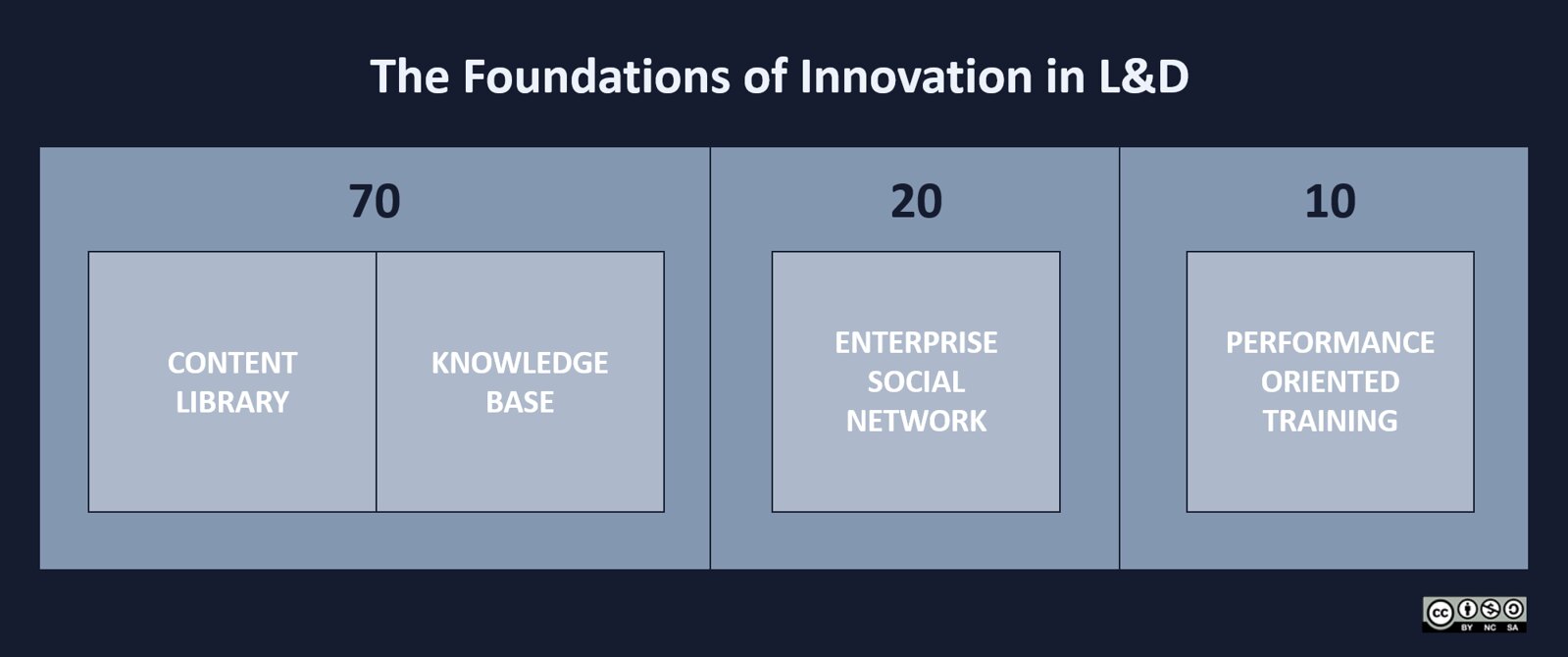There are two sides of the innovation coin in corporate learning & development: technology and pedagogy.
The former is rather obvious and is often conflated with the term innovation. Futuristic hardware and magical software that educates everyone at the press of a button are tempting “solutions”. Some folks call this mindset Shiny New Toy Syndrome, and by golly, it’s a pandemic.
The latter is less obvious because it involves thinking, and I’m not being facetious when I say that thinking is hard. Traditional ways of learning in the workplace are, by definition, ingrained in the psyche of the vast majority of the workforce. Changing the concept of how we learn and redefining how we can help people do it better involve shifting the organisation’s culture, and that is a challenge greater than any IT implementation.
I see technology as an enabler of the pedagogical outcome, rather than it being the outcome per se. And just as we must learn to walk before we can run, so too must an organisation lay the foundations of innovation before it can reach for the stars. Though not as sexy as their more tweeted-about alternatives, these foundations are the building blocks of long-term efficiency, flexibility and creativity.
So what are the foundations of innovation in L&D?
I will hereby attempt to answer this question by looking through the lens of the 70:20:10 model. Whereas previously I have advocated this approach when designing a solution for a specific learning objective, this time I’m elevating the approach to the strategic level, with a view to designing a future-proofed solution for all the organisation’s learning objectives.
The 70
From the get-go, a false idol that must fall is the belief that the role of the L&D department is to create all the training to meet the organisation’s learning needs. These needs are so diverse within and across all the different job roles that the task is an almost comical impossibility.
Moreover, a large proportion of these needs is generic; despite what many organisations think, they’re not that special. Analytics is analytics. Decision making is decision making. Difficult conversations are difficult conversations. The nature of such content is universal.
So my first building block is a third-party content library. There are many players in this space, and sure it makes sense to pick one that matches your organisation’s profile, but their pedagogical purpose is the same: to provide your people with immediate access to an extensive suite of learning assets, covering a broad range of topics, on demand. Such a resource empowers self-directed learning which, in the language of 70:20:10, can be done on the job, just in time.
Another false idol to fall is the myth that all the information we need is at our fingertips. Clearly, not all our needs are generic. The organisation is special in the sense that has its own products, processes, systems, policies, etc, which a third party will never cover.
So my second building block is an in-house knowledge base. Whether the underlying technology is an intranet, CMS or wiki, again the pedagogical purpose is the same: to provide your people with on-demand access to bespoke content that improves performance.
The 20
Despite the best intentions of a content library and a knowledge base, they will never meet every conceivable learning need. An enterprise social network covers the “in-betweens”, principally by empowering everyone to ask their own questions to the crowd, and to keep abreast of emergent knowledge in the moment.
The 10
The building blocks in the 70 and the 20 spearhead an informal first approach to learning and development which lifts a mountain of weight off the shoulders of the L&D team. Freed from the burden of training everything, we can now focus our attention on what should be trained.
Furthermore, these building blocks enable change in the nature of the training. With the bulk of the content hosted elsewhere, it doesn’t need to be shovelled into the course. The class can be flipped, the narrative pared back to its key messages, and a scenario-based design adopted to train not the content, but its application.
In this way, the training becomes performance oriented.
By no means do these building blocks exhaust the 70:20:10 model, nor do they represent the extent of innovation in L&D. Rather, they form the bedrock of further innovation.
For example:
- User-generated content has a home, not only where it can be housed, but also where it can be governed.
- Blended learning goes beyond pre-work online modules by integrating social activity and ongoing performance support.
- Corporate MOOCs have a delivery vehicle.
- Micro-learning and micro-assessments have a rich source of reference content to which remedial feedback can link.
- If the content library, knowledge base and ESN are mobile accessible, they support mobile learning.
- Any reduction in training volume creates more space to explore emerging technologies such as AI, VR and AR.
- An orderly, structured L&D service offering provides the basis for a proper consideration of the value that a next-generation learning management system may add (or not).
So while I remain an advocate of ad hoc innovation, I see it as a necessity in the absence of a plan. My preference is a much more strategic approach, bedding down what matters most to meet the immediate needs of the business, prior to building additional innovative initiatives that stand firmly on that foundation.
In this way, not only do we innovate now, but we have a platform for innovating into the future.


Excellent article Ryan. It makes a lot of sense and I think you are right. Often L&D people with the best intentions, get stuck, and often this is because of the next great idea or shiny new thing. If we bounce from idea to idea and don’t things done, we are failing the business we work for.
It is also really interesting when you really why you were actually hired, isn’t it.
Great post Ryan. I agree that an underpinning strategy is key, from which innovation can flow. Your use of the term ‘building blocks’ and laying a foundation makes a lot of sense. Having come to a workplace keen to jump into the 20-10, I have had to take a step back and re-build the 70 first. It may take a bit longer, but my hope is that it provides the stability we need moving forward.
Thanks for your thought-provoking wisdom, as always.
Thank you both Paul and Elizabeth :)
This is such an innovative post. It is important to add innovation to the learning environment, and using the building blocks example, i think that it will make it more successful
Thanks Simon!
Thanks for this Ryan. I like the idea of outsourcing (but integrating/connecting/contextualising) the generic content that others can create and maintain. This frees L&D up to provide more direct support for the challenges facing people day to day and playing a more deliberate role in helping the organisation build capacity to respond to complexity. I can also see the role of the ESN in bridging, connecting and feeding the 70 and 10 elements you’ve raised.
Good points, Andrew. Integrating / connecting / contextualising the generic content is really important, while I love the notion of the ESN bridging, connecting and feeding the 70 & 10.
Ryan you hit the spot… corporate training needs to be first governed with method and strategy, otherwise you might just disperse energy following the latest shiny buzzword. This is something I see everyday with my clients asking me for “new solutions”, without any continuity or integration with previous or future activities. All those building blocks will just fall down without a building design… so I guess it’s a lot about having a good architecture :)
Thanks for this great post!
Thanks Alberto!
Great perspective